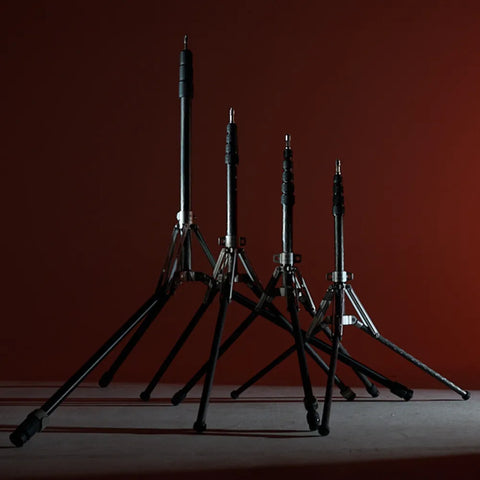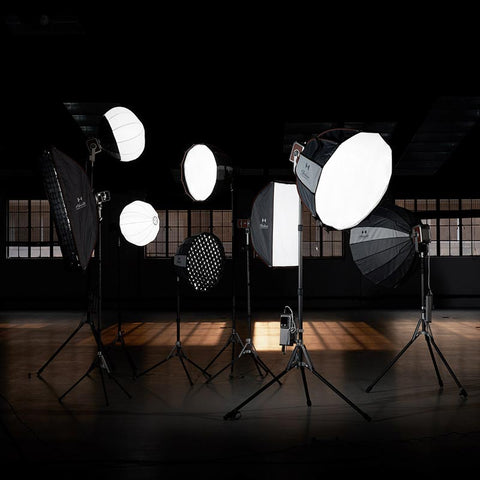Ever have that perfect shot all lined up, only to watch your light crash to the ground? Annoying, right? Even the coolest picture needs good lighting, and that’s where a solid light stand comes in. It's not just some extra piece of gear; it's what keeps your lights steady and lets you get the look you're after. It gives you the stability and control you need, so you can nail those shots every time.
The 3 Building Blocks of Quality Light Stands
Good photography lighting starts with a good light stand. Here's what to look for:
Stability: The Most Important Thing
When it comes to light stands, stability is key. Even tiny movements can mess up your lighting and ruin a shot. The best light stands have wide bases and strong legs to keep everything rock solid. Many also have hooks where you can hang weights for extra stability, which is super helpful when you're using heavier lights or shooting outside on a windy day.
If your light stand is wobbly, your pictures will be blurry, your lighting will be off, and you could even damage your gear. When you're checking out a light stand, see how steady it is when you raise it all the way up. Good ones will stay put even when they're fully extended.

Weight Capacity: Make Sure It Can Handle Your Gear
Different lights need different stands. A small stand might be fine for a little LED light, but it won't be able to hold a big strobe with attachments. Before you buy, check the weight rating and make sure it's higher than the weight of your heaviest light setup – at least 20% higher, just to be safe.



- Regular price
- Sale price
- $299.00
If you're using lights that create strong, focused beams (point source lights), you'll need an especially sturdy stand. These lights can create dramatic shadows, so you don't want the stand to move even a little bit. The best light stands for point source lights will keep them perfectly still. Speaking of sturdy, for ultimate stability and lightweight portability, check out a carbon fiber tripod light stand from Harlowe. They're an investment, but worth it for peace of mind.
Height Adjustment: Getting the Light Exactly Where You Want It
When you're setting up your lights, you need to be able to put them exactly where you want them, so being able to adjust the height of your light stand is super important. Good light stands are designed to be adjusted easily and precisely. Pros need stands that can be adjusted hundreds of times without getting wobbly or slipping.
Most good light stands will let you:
- Go as low as 2-3 feet for low-angle shots, product photos, or lighting someone who's sitting down.
- Extend to 7-10 feet for overhead lighting, hair lights, or taking pictures of groups of people.
- Lock the height in place with twist-lock collars or levers that won't slip.
- Make tiny adjustments to get the light exactly where you need it, even down to the inch – perfect for getting the right catchlights in someone's eyes or controlling shadows.
- See exactly how high the stand is set with markings on the sections, so you can set it up the same way every time.
Being able to adjust the height is especially useful for LED lights, because you often need to put them at just the right angle to control how wide the beam is and how bright it is. For those tricky angles, the Flexible FlexMount Tripod for Lighting from Harlowe could be a game changer. It lets you position your lights in ways you never thought possible.

The Material of Your Light Stand Matters
When you're shopping for light stands, you'll see that they're made of different materials. Each material has its own advantages, depending on what you need the stand for. The material affects how heavy and durable the stand is, but it also affects things like how it handles heat and cold, whether it rusts, and how well it absorbs vibrations.
Aluminum: The Popular Workhorse
Aluminum light stands are everywhere, and there's a good reason for that. They're a good mix of strong, light, and affordable, which makes them useful for lots of different types of photography. Photographers who work in a studio especially like aluminum stands because they're a bit heavier, which makes them more stable. That's a big plus when you don't have to carry them around all the time.
- Design: Most aluminum stands have three sections that slide into each other, so you can make them taller or shorter. They have collars or levers that lock the sections in place.
- Safety: The nicer aluminum stands often have air cushioning. This is important because if one of the locks fails, the stand will slowly lower instead of crashing down and breaking your expensive lights.
- Rust: If you're shooting in a humid place or near the ocean, look for aluminum stands that have been anodized. This makes them resist rust better, so they'll last longer.
- Reliability: A lot of pros like aluminum stands because they last a long time. Even though they might cost more upfront than cheaper stands, they often end up being a better deal because they can handle years of use.
Carbon Fiber: The Traveling Photographer's Friend
If you're a photographer who's always traveling, carbon fiber light stands are a good choice, though they do cost more. They're much lighter than aluminum stands, but they're still just as strong and can hold just as much weight. This makes them perfect for shooting on location when you need to keep your gear as light as possible without sacrificing stability.
- Vibration: Carbon fiber absorbs vibrations well, which is helpful if you're shooting in a place where there are people walking around, wind, or anything else that might cause the stand to shake. This helps you get sharper photos.
- Temperature: Carbon fiber works well in a wider range of temperatures than aluminum, which can expand or shrink a little depending on how hot or cold it is.
- Who Should Buy: Wedding photographers who travel, adventure photographers, and photojournalists often find that carbon fiber stands are worth the extra money.
- Is It Worth It?: If you're a pro who needs to carry your gear around a lot and wants the best performance in tough situations, the lighter weight of carbon fiber can make a big difference, even if it costs more. You'll be less tired after a long day of shooting.
The Right Height for Different Photography Styles
The height of your light stand is really important for getting the lighting you want in your pictures. Different kinds of photography need the lights in different places, so you'll need different light stand heights. Here's a quick guide to help you figure out the best light stand height for different types of photography:
| Photography Style | Best Light Stand Height & What to Think About |
| Portrait | 5-7 feet, placed at or a little above the person's eyes. |
| Food | Low angles, so you need stands that can go really low to the ground. |
| Architectural | You might need 12+ feet to light up ceilings and high walls. |
| Fashion | You'll need different heights depending on whether the model is sitting or standing. |
| Product | You need to be able to adjust the height very precisely to get the light exactly where you want it. |
| Wedding | Tall enough to get the lights above the dance floor and avoid harsh shadows. |
| Children | Make sure the locks are strong, because kids move around a lot. |
| Commercial (Large Products) | Stands that are low to the ground will be more stable and won't have legs sticking out everywhere. |
| Sports | Small stands that don't take up much space, but are still tall enough for shooting from the sidelines. |
Elevate Your Photography with the Right Light Stand
The right light stand can make lighting your photos much easier and more effective. Whether you choose a professional studio stand, a lightweight portable one, or a specialized mount, investing in a good light stand directly improves the quality of your images. Start playing around with different lighting positions and see how your photos go from flat to dynamic – all because you have a reliable foundation to support your creative ideas. Pairing the appropriate light stand with the right lighting equipment and mastering practical lighting techniques transforms ordinary photography into compelling visual storytelling.






